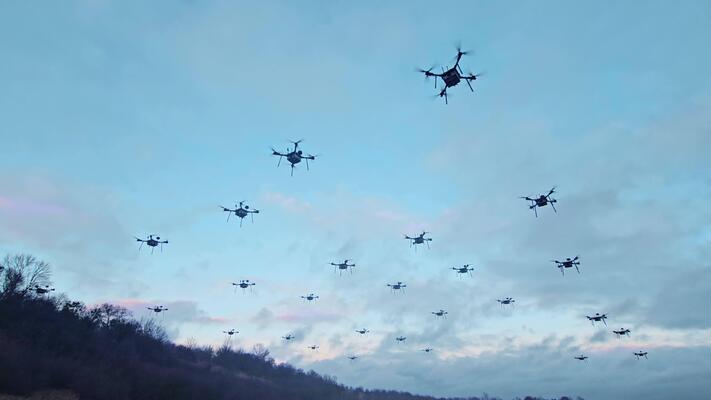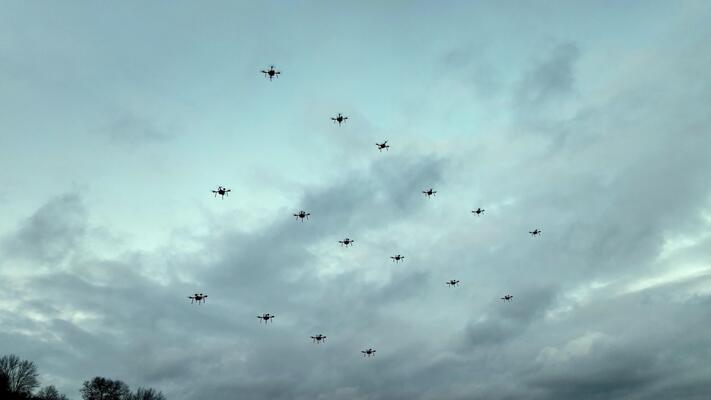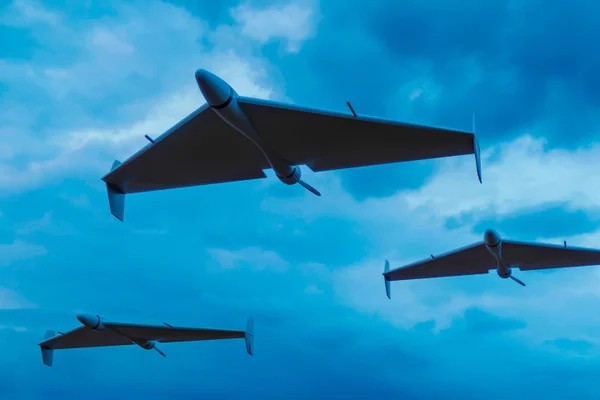The familiar drone of a single propeller in the sky is rapidly being replaced by a far more complex and formidable sound: the whisper of a coordinated, intelligent swarm. We are standing at the precipice of a new technological epoch where the convergence of artificial intelligence, robotics, and advanced sensor technology is giving rise to autonomous drone systems capable of collaborative thought and action. This isn’t a distant sci-fi concept; it’s the current frontier of development, fundamentally reshaping everything from military doctrine to precision agriculture. This evolution is a central theme in today’s Drones & AI News, signaling a paradigm shift from remotely piloted aircraft to self-governing aerial platforms.
The core innovation lies in moving the decision-making process from a human operator on the ground to an AI model onboard the drone itself. These systems can perceive their environment, communicate with their peers, and execute complex, multi-part missions without direct human intervention. As we delve into this transformative technology, we will explore the intricate anatomy of these AI swarms, the sophisticated tech stack that powers them, and the profound strategic and ethical implications they present for our future. This is more than just an update in Robotics News; it’s the beginning of a new chapter in autonomous systems.
The New Battlefield: Anatomy of an AI-Powered Drone Swarm
The concept of an autonomous drone swarm represents a quantum leap beyond traditional unmanned aerial vehicles (UAVs). Where a single Predator drone requires a team of human operators for piloting and sensor analysis, an AI-driven swarm operates on the principle of decentralized, collective intelligence. This shift is enabled by several key technological pillars that work in concert to create a cohesive and adaptive fighting force.
From Remote Control to Autonomous Command
The journey to autonomy has been gradual. Early drones were essentially remote-controlled planes. The next generation introduced semi-autonomous features like GPS-based waypoint navigation and auto-landing. Today, we are witnessing the emergence of true autonomy. This is a major topic in Autonomous Vehicles News, where the challenges of self-driving cars share common ground with aerial autonomy. The critical difference is the speed and three-dimensional complexity of the aerial domain. Onboard processors, a key focus of AI Edge Devices News, are now powerful enough to run complex AI models directly on the drone. This “edge computing” drastically reduces latency, eliminates the risk of jammed communication links, and allows for real-time decision-making in dynamic, hostile environments.
The ‘Brain’ of the Swarm: AI and Machine Learning Models
At the heart of these swarms is not a single, monolithic AI but a sophisticated interplay of machine learning models. Reinforcement learning is a primary training method, where AI agents are placed in millions of simulated combat scenarios. They learn optimal strategies for dogfighting, evasion, and target acquisition through trial and error, much like an AI learns to master a complex game. This continuous digital training is a hot topic in AI Research / Prototypes News. Furthermore, some systems are now incorporating Large Language Models (LLMs) to interpret high-level, natural language commands from human operators. A commander might issue a directive like, “Secure airspace over this sector and deny enemy reconnaissance,” and the AI swarm commander translates that intent into a series of coordinated tactical actions for the individual drones. This AI interprets a constant stream of data from its sensors, making the latest developments in AI-enabled Cameras & Vision News and AI Sensors & IoT News absolutely critical to its operational effectiveness.
Swarm Intelligence: More Than Just a Group of Drones
Swarm intelligence is the emergent behavior that arises from simple rules followed by individuals in a decentralized system. No single drone is the “leader.” Instead, each unit communicates its position, status, and sensor data with its neighbors, collectively building a shared understanding of the battlefield. If one drone is lost, the swarm dynamically re-organizes and adapts its strategy to complete the mission. This resilience is its greatest strength. The swarm can collaboratively identify a target, assign the best-positioned drone to engage, and have other drones provide cover or electronic countermeasures simultaneously. This decentralized approach is a core principle being explored across the field of robotics, from AI Personal Robots News to advanced manufacturing.

The Technology Stack: Powering Autonomous Aerial Combat
Creating an effective AI drone swarm requires a tightly integrated stack of hardware, software, and communication technologies. Each layer must be robust, resilient, and capable of operating under the extreme pressures of a contested environment. This is where cutting-edge research meets battlefield reality.
Hardware and Sensors: The Eyes and Ears
The physical drone platform is an engineering marvel of efficiency and power. Lightweight composite materials house powerful edge computing modules, long-range communication arrays, and a versatile payload bay. The sensor suite is the AI’s window to the world. It typically includes:
- Electro-Optical/Infrared (EO/IR) Cameras: High-resolution cameras for visual identification of targets in various light and weather conditions, a key area of AI Cameras News.
- LiDAR and Radar: For creating detailed 3D maps of the environment, detecting obstacles, and tracking other aircraft, even those designed to be stealthy.
- Signals Intelligence (SIGINT) Sensors: To detect and locate enemy communication signals and radar emissions.
Simulation and Training: The Digital Proving Ground
An AI pilot cannot be trained in the real world; the cost, time, and risk are prohibitive. Therefore, the most critical component of the development pipeline is the digital twin—a hyper-realistic, physics-based simulation of the real world. In this virtual environment, AI models can “fly” millions of hours, engaging in thousands of combat scenarios against simulated adversaries, including other advanced AIs. This is where the AI learns, adapts, and hones its tactics. The fidelity of these simulations is paramount, incorporating complex variables like weather, electronic jamming, and terrain. This methodology of training AI in virtual worlds has parallels in AI in Gaming Gadgets News, where AI opponents are becoming increasingly sophisticated and human-like.
The Human-Machine Interface: A New Role for the Operator
As drones become more autonomous, the role of the human operator evolves from a hands-on pilot to a strategic commander or mission manager. The concept of a “human-in-the-loop,” where a person must approve every lethal action, is giving way to “human-on-the-loop,” where a human oversees the general mission and can intervene if necessary. Future interfaces will likely involve technologies highlighted in AR/VR AI Gadgets News and Smart Glasses News, where a commander can visualize the entire battlespace in 3D, interacting with the swarm through voice commands and gestures. Looking further ahead, speculative research in Neural Interfaces News even imagines a future where a human operator could command a swarm with the speed of thought.
Strategic Implications and Ethical Quagmires
The rise of AI-powered drone swarms is not just a technological advancement; it’s a strategic and ethical earthquake. It challenges long-held military doctrines and forces a global conversation about the future of warfare and the role of humanity in it.
Redefining Military Doctrine

For decades, air power has been defined by increasingly expensive and sophisticated manned fighter jets. AI swarms flip this paradigm on its head. The new doctrine may favor mass over complexity—the idea of overwhelming a billion-dollar fighter jet with a thousand low-cost, “attritable” (expendable) drones. This has massive implications for air superiority, reconnaissance, and defense budgets. The ability to deploy a persistent, intelligent, and risk-tolerant surveillance network is a game-changer for intelligence gathering, making this a critical topic in AI Security Gadgets News and AI Monitoring Devices News. The speed of AI-driven combat could shrink decision-making timelines from minutes to microseconds, creating a volatile environment where automated systems engage each other in flashes of high-speed conflict.
The Civilian Crossover: Dual-Use Technology
Like GPS and the internet, technologies developed for the military often find powerful applications in the civilian world. The same swarm intelligence that guides a combat drone can be repurposed for immense good. Imagine swarms of drones:
- Conducting precision agriculture, monitoring crop health plant-by-plant, a revolution for AI Gardening / Farming Gadgets News.
- Rapidly mapping disaster zones after an earthquake or hurricane, locating survivors and assessing damage.
- Inspecting critical infrastructure like bridges, power lines, and pipelines with unprecedented speed and detail, a boon for Smart City / Infrastructure AI Gadgets News and AI for Energy / Utilities Gadgets News.
- Fighting wildfires by creating coordinated, 24/7 fire lines.
The Pandora’s Box of Autonomous Weapons
The most pressing concern is the ethical dilemma of Lethal Autonomous Weapon Systems (LAWS)—machines that can independently select and engage targets without direct human approval. This raises profound questions that we are ill-prepared to answer. Who is accountable if an autonomous swarm makes a mistake and causes civilian casualties—the programmer, the commander, or the machine itself? How can we guarantee an AI can reliably distinguish between a combatant and a non-combatant in the chaotic “fog of war”? There is a significant global movement calling for treaties to ban or regulate LAWS, fearing that their proliferation could lead to a terrifying new arms race and a future where life-and-death decisions are fully delegated to algorithms.
The Path Forward: Recommendations and Future Outlook
Navigating the development and deployment of this powerful technology requires a careful, considered approach. The allure of a decisive technological advantage must be balanced with the immense responsibility it entails. As this technology matures, certain best practices and considerations are essential.

Tips and Considerations for Development
First, Robust Testing and Evaluation (T&E) is non-negotiable. AI systems must be subjected to rigorous, adversarial testing in a wide range of simulated and real-world environments to identify and mitigate potential failures or unintended behaviors before deployment. Second, establishing clear Ethical Frameworks and Human Oversight is critical. This means programming systems with strict, unalterable rules of engagement and ensuring that a meaningful level of human control is always maintained, especially regarding lethal force. Finally, we must anticipate the development of Counter-AI Systems. For every autonomous swarm, an anti-swarm system will be developed, leading to a new, high-stakes arms race in artificial intelligence itself.
The Future is Autonomous
The trend toward autonomy is undeniable and extends far beyond the sky. We see its principles in everything from Robotics Vacuum News to the complex logistics of global shipping. The future will likely see the integration of air, ground, and sea-based autonomous platforms into a single, cohesive network. An AI swarm in the air could provide real-time intelligence to autonomous ground vehicles, all coordinated by a central AI battle manager. This level of integration will continue to push the boundaries of what’s possible, influencing civilian fields from AI for Travel Gadgets News to AI in Sports Gadgets News, where drone-based camera work is already becoming autonomous.
Conclusion
The emergence of AI-powered autonomous drone swarms marks a pivotal moment in technological history. These systems are no longer theoretical but are actively being developed and tested, promising to fundamentally alter the landscape of modern security and warfare. They represent a convergence of the most advanced fields in AI, robotics, and sensor technology, showcasing both incredible potential and significant peril. The same intelligence that could one day orchestrate a flawless military operation could also revolutionize disaster relief and environmental monitoring. As we move forward, the global conversation—among engineers, policymakers, ethicists, and the public—is more critical than ever. The latest Drones & AI News is not just about gadgets; it’s about defining the guardrails for a future where intelligent machines operate with unprecedented autonomy, and ensuring that this powerful technology serves to enhance, not diminish, human security and values.










